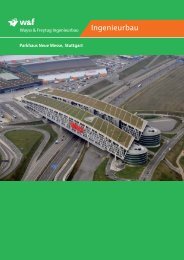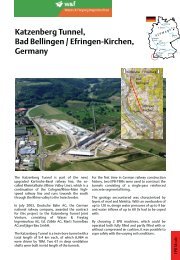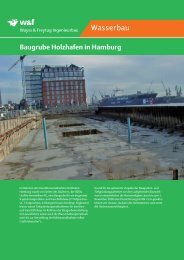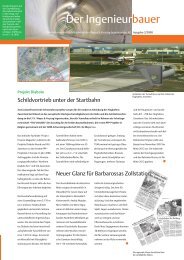Tunnels - Wayss & Freytag Ingenieurbau AG
Tunnels - Wayss & Freytag Ingenieurbau AG
Tunnels - Wayss & Freytag Ingenieurbau AG
Create successful ePaper yourself
Turn your PDF publications into a flip-book with our unique Google optimized e-Paper software.
Year<br />
<strong>Tunnels</strong><br />
Connections for the Future<br />
Creative engineering is our main focus. We understand design, conception and execution to be individually<br />
developed solutions in response to the tasks set by our clients.<br />
As an internationally renowned construction company, we design environments, establish permanent<br />
connections between people and places and thus achieve perceptible improvements for both clients and<br />
users. In short: We create quality of life for the world of tomorrow.<br />
Customer-oriented thinking and responsible actions form the basis of our business. After all, the success<br />
of each and every construction project is always closely linked to the quality of cooperation with our<br />
clients.<br />
<strong>Wayss</strong> & <strong>Freytag</strong> <strong>Ingenieurbau</strong> <strong>AG</strong> is a member of the Royal BAM Group, one of the biggest European<br />
construction companies with its head office in the Netherlands. This powerful foundation enables us<br />
to take full advantage of all chances offered by international cooperation. For our clients this results<br />
in the greatest possible transparency in all phases of a project as well as availability of comprehensive<br />
know-how in conjunction with maximum regional presence.<br />
At <strong>Wayss</strong> & <strong>Freytag</strong> <strong>Ingenieurbau</strong> <strong>AG</strong> more than 130 years of experience and the technological<br />
expertise of today converge. A lean structure ensures the optimum realization of our clients‘<br />
projects. In our competence centres created just for this purpose specialist groups of our best<br />
staff work in close cooperation to find the most appropriate solution for every technological<br />
challenge.<br />
<strong>Wayss</strong> & <strong>Freytag</strong> <strong>Ingenieurbau</strong> <strong>AG</strong> is active worldwide in the field of tunnelling. On the<br />
international market, the company carries out projects in which it distinguishes itself by its<br />
special know-how and excellent performance.<br />
The scope of our activities ranges from mechanized and conventional tunnelling, the<br />
construction of sewage treatment plants and power plants, railway, bridge and stadium<br />
construction and industrial construction to environmental technology. Engineering consulting,<br />
location analyses, utilization concepts and feasibility studies complete our range of services.<br />
Mechanized Tunnelling<br />
In the past <strong>Wayss</strong> & <strong>Freytag</strong> was significantly involved in the development of mechanized<br />
tunnelling techniques. For example, they initiated the support of the tunnel face by means of a<br />
bentonite suspension and air-cushion. With the so-called “slurry shield” this technique was<br />
brought to operational maturity. <strong>Wayss</strong> & <strong>Freytag</strong> is a pioneer of this technique and has in the<br />
meantime driven more than 100 km of tunnel using slurry shields. In addition, more than 70 km of<br />
tunnel were driven using earth pressure balance shields and 30 km using hard rock TBMs.<br />
Conventional Tunnelling<br />
The construction of tunnels using conventional construction methods has always been a challenge to<br />
every engineer. Here, the engineer’s most important task is the evaluation of the geology and the<br />
selection of the right means of securing the excavation face until final completion of the inner lining.<br />
<strong>Wayss</strong> & <strong>Freytag</strong> already rose to this challenge in 1905 when building a railway tunnel using the<br />
conventional tunnelling method in Wasserburg/Inn in gompholite (Nagelfluh) and gravel.<br />
The range of conventional tunnelling reaches from soft rock tunnelling (e. g. a metro tunnel in Munich<br />
gravel) and tunnelling in compressed air (e. g. Ostbahnhof metro station in Munich in Tertiary formations<br />
below groundwater) to classic drill and blast drives (e. g. Rennsteig Tunnel on the A 71 motorway, which, with a<br />
length of 8 km, is the longest motorway tunnel in Germany).<br />
Summary of TBM-driven tunnels:<br />
120<br />
100<br />
80<br />
60<br />
40<br />
20<br />
0<br />
1 9 7 4<br />
1 9 7 5<br />
1 9 7 6<br />
1 9 7 7<br />
1 9 7 8<br />
1 9 7 9<br />
1 9 8 0<br />
1 9 8 1<br />
Hydroshield<br />
Total Driven Tunnel Length (km)<br />
1 9 8 2<br />
1 9 8 3<br />
1 9 8 4<br />
1 9 8 5<br />
1 9 8 6<br />
1 9 8 7<br />
1 9 8 8<br />
1 9 8 9<br />
1990<br />
1 9 9 1<br />
1 9 9 2<br />
1 9 9 3<br />
1 9 9 4<br />
EPB shield<br />
1 9 9 5<br />
1996<br />
1 9 9 7<br />
1 9 9 8<br />
1999<br />
2000<br />
2 0 0 1<br />
2002<br />
2003<br />
2004<br />
2005<br />
2006<br />
2007<br />
2008<br />
Hard Rock TBM<br />
121,8<br />
70,7<br />
34,1<br />
2009<br />
2 0 1 0<br />
2 0 1 1











